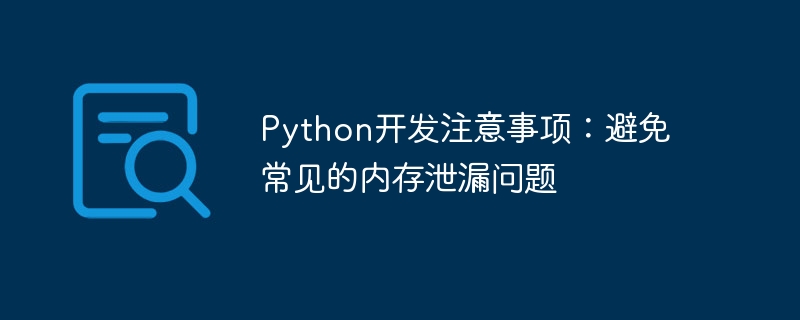

As a high-level programming language, Python has the advantages of being easy to learn, easy to use and highly efficient in development, and is becoming more and more popular among developers. However, due to the way its garbage collection mechanism is implemented, Python is prone to memory leaks when dealing with large amounts of memory. This article will introduce the things you need to pay attention to during Python development from three aspects: common memory leak problems, causes of problems, and methods to avoid memory leaks.
1. Common memory leak issues
A memory leak refers to a situation where the memory space allocated by a program during operation cannot be released, eventually causing the entire system to crash or become unresponsive. Common memory leak problems in Python include the following:
The garbage collection mechanism in Python is based on reference counting. When an object is created, the system automatically allocates memory for it and sets the reference count to 1. Every time the object is referenced, its reference count is incremented by 1, and every time the object is released, its reference count is decremented by 1. When the reference count reaches 0, the object's memory will be automatically reclaimed.
However, due to developer negligence or logic problems in the program, the reference count of the object may be incorrect, for example:
egin{lstlisting}[language=python]
def test():
a = [] a.append(a) return a
test()
end{lstlisting}
In the above code, variable a points to an empty list and adds itself to the list. This way variable a cannot be removed from this list, so its reference count will never be 0, causing a memory leak.
If there are operations in the program that occupy memory for a long time, such as reading large files, processing big data, etc., it may cause memory leaks. . For example:
egin{lstlisting}[language=python]
file = open("big_file.txt")
data = file.read() # Read the entire file
end{lstlisting}
In the above code, file.read() reads the entire file into memory. If the file is too large, it will occupy a large amount of memory, causing the system to crash.
Objects in Python can reference each other to form a grid-like structure. If a circular reference occurs in this structure, it will cause a memory leak. For example:
egin{lstlisting}[language=python]
class Node():
def __init__(self, value): self.value = value self.next = None
a = Node(1)
b = Node(2)
a.next = b
b.next = a # Circular reference
end{lstlisting}
In the above code, the node a and node b refer to each other, forming a circular reference structure. If there are a large number of nodes in such a structure, it can lead to memory leaks.
2. Causes of the problem
The causes of Python memory leak problems are as follows:
When there are circular references between objects, the garbage collector cannot correctly determine which objects can be recycled and which objects need to be retained.
When using weak references, you must pay attention to destroying the weak references in time, otherwise it will cause memory leaks.
When the developer is negligent or the logic in the program is confusing, it may cause the object's reference count to be incorrect, resulting in a memory leak.
When performing some operations that occupy memory for a long time, such as reading large files, processing big data, etc., memory leaks may also occur. .
3. Methods to avoid memory leaks
In order to avoid the occurrence of Python memory leaks, developers can start from the following aspects:
When we use the del statement, we can manually release the object to avoid redundant memory usage. For example:
egin{lstlisting}[language=python]
a = []
b = a
del a
end{lstlisting}
In the above code, we use the del statement to manually release the object pointed to by variable a, thus avoiding redundant memory usage.
When using weak references, we can use the weakref module to create weak references and destroy them in time when there is no need to use weak references. they. For example:
egin{lstlisting}[language=python]
import weakref
class MyClass():
def __init__(self, value): self.value = value
obj = MyClass(1)
ref = weakref.ref(obj) #Create a weak reference
del obj
if ref() is None: #Check whether the referenced object exists
print("Object does not exist")
end{lstlisting}
In the above code, we use the weakref module to create a weak reference, and after destroying the object, check whether the referenced object exists. If the referenced object does not exist, it means that the object has been collected by the garbage collector.
Avoiding circular references is one of the important ways to avoid Python memory leaks. When writing code, try to avoid circular reference structures. If you really need to use a circular reference structure, you can use the Python built-in module weakref to solve the problem.
When performing operations that occupy memory for a long time, you should try to avoid reading the entire file or processing the entire data set at once. Memory usage can be reduced by reading or processing in batches.
To sum up, in order to avoid the occurrence of Python memory leaks, during the development process, we should pay attention to handling the reference count of the object, using the del statement to manually release the object, destroying weak references in a timely manner, and avoiding circular references. Structure, pay attention to memory usage, etc. Only through reasonable coding standards and excellent programming practices can the occurrence of Python memory leaks be effectively avoided.
The above is the detailed content of Python Development Notes: Avoid Common Memory Leak Problems. For more information, please follow other related articles on the PHP Chinese website!




